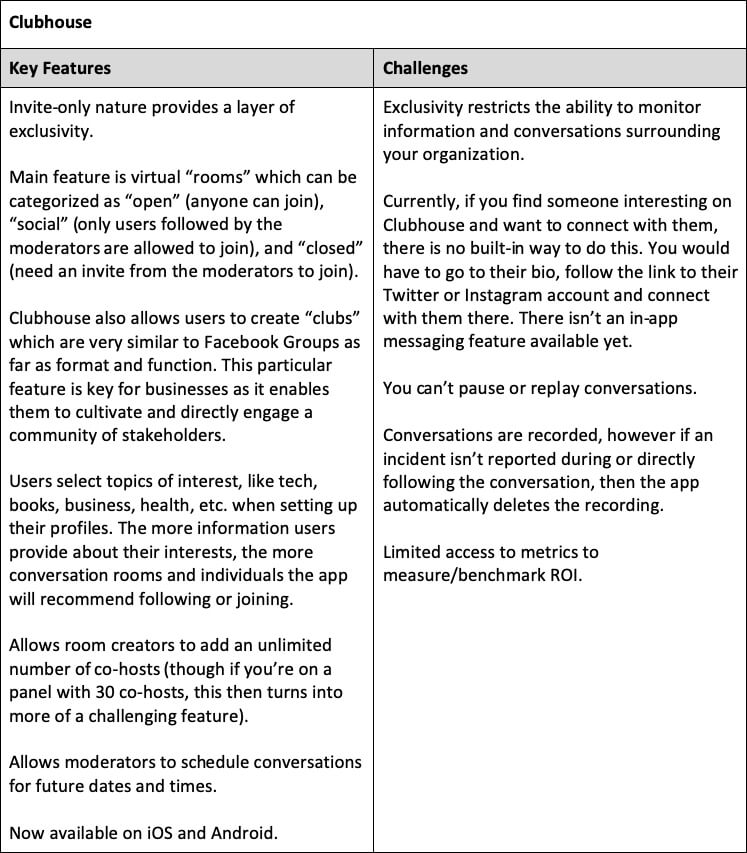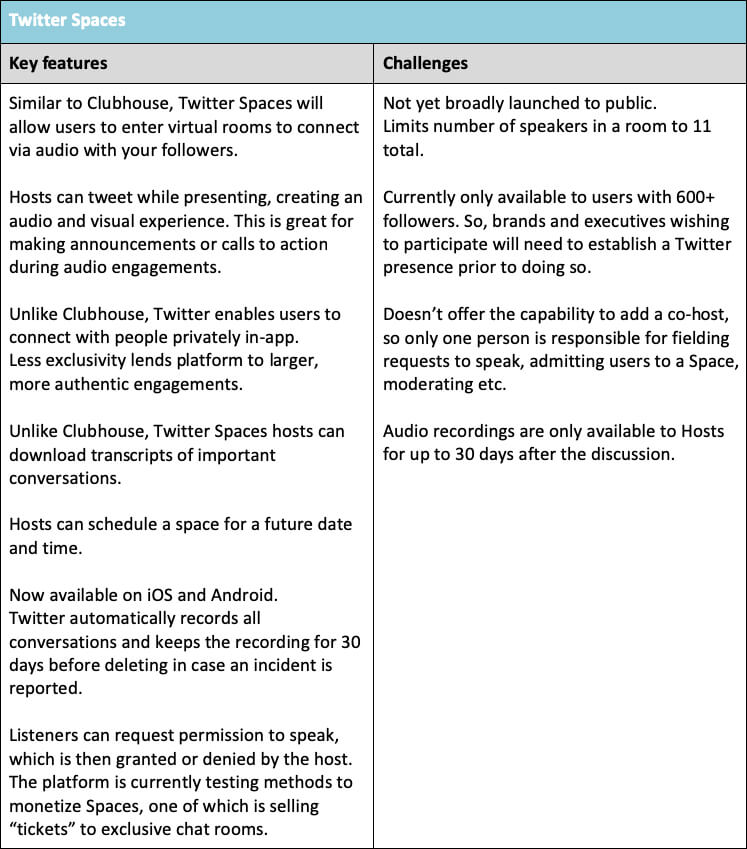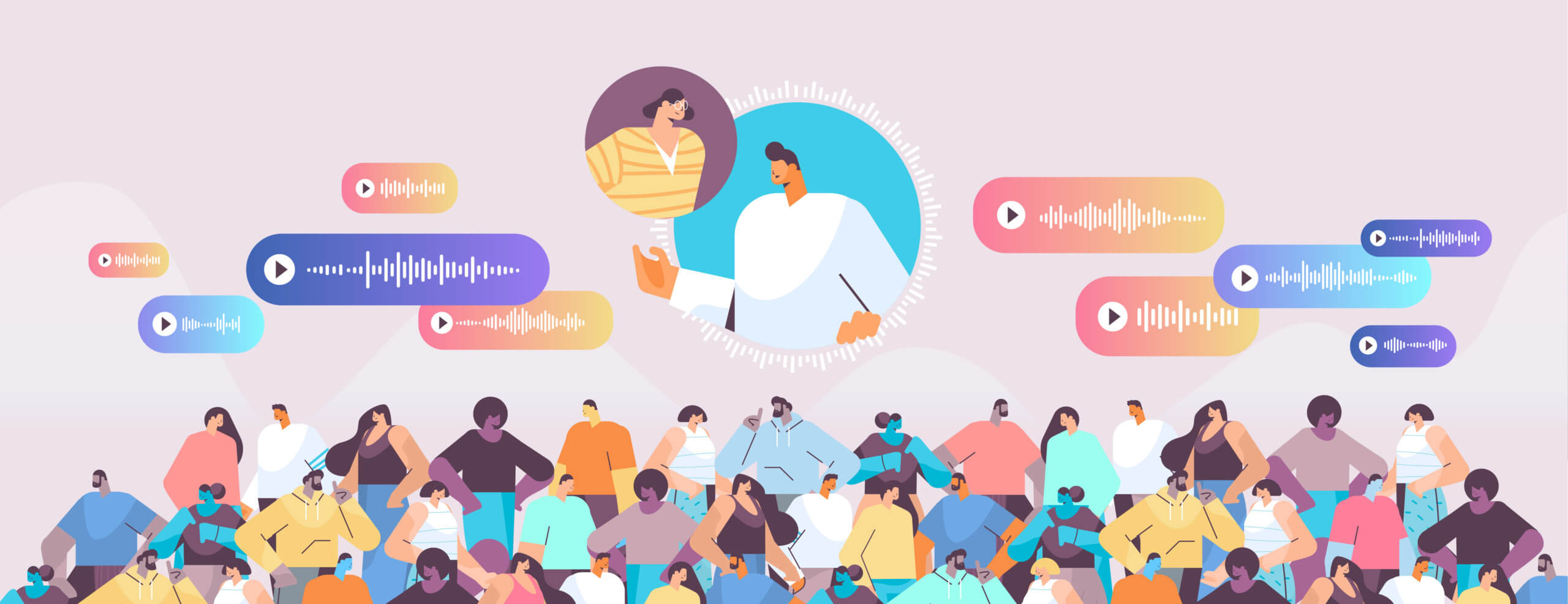Portions of this article were featured in PR Daily: 4 rules to follow when getting into social audio platforms
Social media has continued to present new challenges and opportunities for businesses, their leaders, and consumers alike. The past year has caused a serious shift in communication needs for companies, in particular a much stronger focus on brands’ missions and values. Companies are having to reexamine their corporate impact on society and their communities as key stakeholders are no longer interested in basic products or services; rather, how brands are making a difference in the world. All creating the perfect storm for the emergence of social audio platforms.
While social audio platforms may not be a great fit for every organization, keeping a finger on the pulse of the growth of social audio platforms is a good practice to adopt – especially for organizations looking to expand their digital reach beyond the primary platforms (Facebook, LinkedIn, Twitter, Instagram) over the next several years.
What are Social Audio Platforms?
Social audio platforms are a subset of social media where users can communicate by audio on a shared app. Similar to podcasting, but with real-time, interactive features, these platforms allow users to connect via audio without text or video. Since its inception, social audio platforms have primarily been used to foster human connection amid a global pandemic but have since rapidly increased in popularity among organizations. In fact, well-known brands, such as Kool-Aid and Milk Bar, were some of the earliest among consumer-facing organizations to expand their social media presence to Clubhouse.
Apps including Clubhouse, Twitter Spaces, Facebook Live Audio Room, and more, are worth keeping an eye on as they have the potential to present organizations a new and impactful avenue for engaging with key stakeholders. Whether an organization is a seasoned veteran on social media or just getting started, conducting the appropriate amount of research and weighing the feasibility and potential ROI of engaging on a new channel is essential. Just because a platform is growing in popularity doesn’t mean it’s the right fit for your brand. To kick start your research, we’ve detailed the key features and known obstacles of the two most popular social audio platforms in the next section.
How do the leading social audio platforms compare?
There are several social audio platforms currently competing in a popularity contest. In an effort to outshine comparable platforms, we’ve seen top contenders regularly tease and rollout new feature designed to attract individual users as well as businesses. Of the social audio platforms available, the two most competitive options right now are Clubhouse and Twitter Spaces. See below for an overview of each platform’s key features as well as the current challenges they present:


While Clubhouse and Twitter Spaces are currently the most popular audio platforms available, they face notable competition as other mainstream platforms jump on the audio bandwagon. The following is a sampling of the social audio competitive landscape. While there are several new platforms in the works, these already-established digital platforms with a notable, global user base have a leg up on new competitors:
- Spotify – just announced the launch of its own Clubhouse competitor, Greenroom. The audio platform acquired Betty Labs, the company behind the live sports audio app Locker Room, which rebranded and expanded its focus to music, culture, and sports content.
- Facebook – The tech giant has been investing in audio technologies for a long time and has officially rolled out its long awaited Live Audio rooms. Facebook also has plans to launch its new in-app audio creation tool, Soundbites, later this year.
- LinkedIn – While details surrounding LinkedIn’s competitive audio offering are limited, the platform did confirm its investment in audio technology and plans to integrate audio throughout current features such as events and groups.
It’s still too soon to tell if social audio platforms will sustain long-term popularity or experience short-term glory on the path to becoming the next Google +. Regardless of these platforms’ success, the current buzz they’ve created is enough reason for communications teams to keep social audio platforms on their radars. Specifically, we’d recommend paying attention to new features as they roll out, including overall benefits (if any), user adoption and feedback on effectiveness (from an individual and business perspective).
As with any social platform, organizations should also monitor if/how key competitors/peers are using social audio platforms and whether their strategy appears to be effective – this information is often a determining factor when considering whether or not to expand to any digital channel.
What are some tips for effectively leveraging social audio platforms?
As of right now, all signs point to social audio platforms as the future of content marketing – though who’s to say that’ll ring true by this time next year? Like many new social platforms, advertising options and features specific to marketers, come last. So even if social audio platforms are here to stay, you have some time to explore your options and determine whether or not they’re a fit for your organization.
If/when you decide to expand your digital presence to social audio platforms, here are few tips and best practices for establishing a presence on social audio platforms and ultimately elevating the visibility of your key initiatives:
- Commit to consistency. Social audio platforms aren’t for organizations that want to allocate budget instead of time. To be seen as a thought leader on a social audio platform, you need to be active. In fact, Clubhouse won’t let users create a club until they’ve hosted at least three rooms within a week.
- Listen and learn. Joining rooms/spaces to listen to the discussion is just as important as participating in or regularly hosting your own discussion. Before you begin building a content strategy for the new platform, seek to spend 24 hours listening and learning about the topics of interest among your target audience members. Look to follow and join a wide range of discussions, clubs and individuals relevant to your business and its core initiatives. For example, a company launching a new and improved CSR initiative should seek to join CSR related clubs, participate in general environmental and business discussions, and follow other business leaders on the platform to learn how they’re delivering similar messages.
- Be authentic and transparent. Social audio platforms are great avenues for tapping into trust and encouraging newer audiences to invest in users who spend time sharing their expertise. So rather than rattling off overly rehearsed key messages, strive to foster personalized and transparent conversation by focusing on the “why” behind your brand and its core initiatives. Remember, this isn’t a one-and-done speaking opportunity, it’s a single piece of a broader narrative you’ll build by consistently engaging over an extended period of time.
- Leverage partnerships. Consider inviting partner organizations to co-host discussions with you in order to increase your credibility on the platform. We’ve seen brands in the past leverage celebrity and influencer partners in panel discussions to create buzz around important initiatives.
